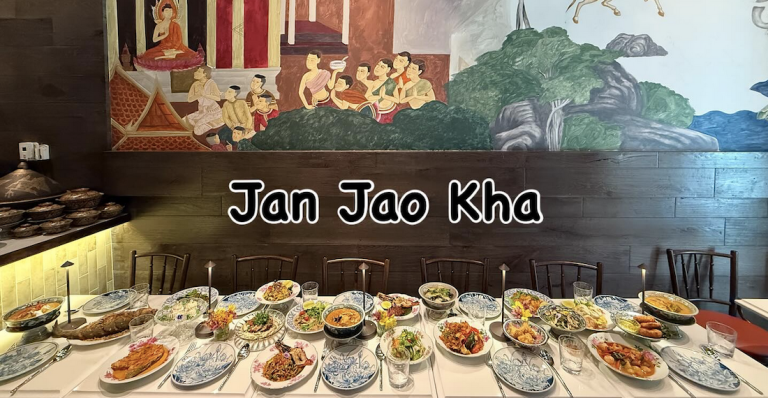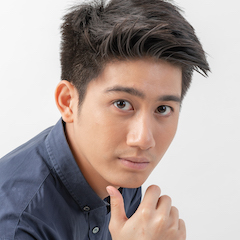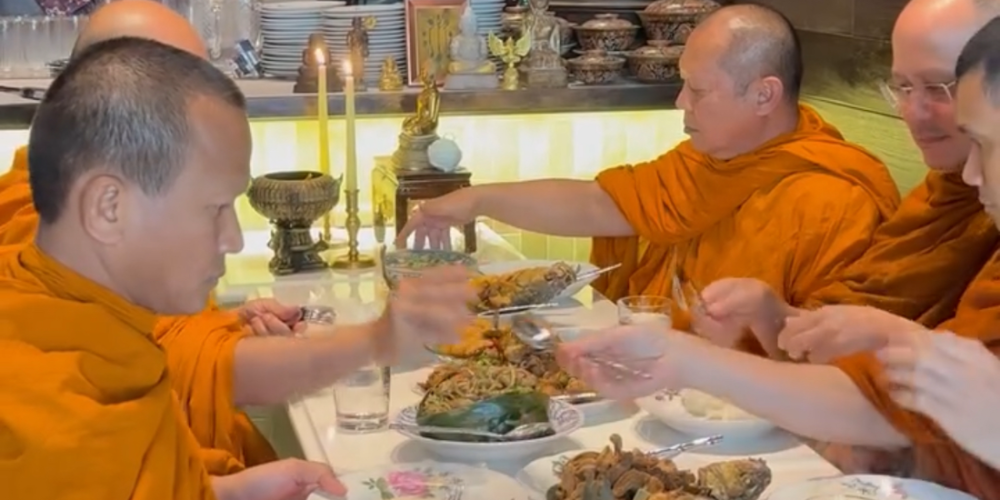
New Jan Jao Kha Illuminates N.Y.C. with Exquisite Recipes from the Sukhothai and Ayutthaya Eras, Once Reserved for Nobility and Thought Lost to Time.


New York, N.Y. — The relentless, neon-drenched pulse of Hell’s Kitchen seems an unlikely place for a quiet culinary resurrection.
Yet, on Ninth Avenue, a subtle glow beckons, promising a passage not just across the city, but across centuries.
Jan Jao Kha (จันทร์เจ้าขา), a new restaurant whose name is an affectionate plea to the moon, has opened its doors, offering a rare portal to the royal kitchens of ancient Siam.
Here, under the curated ambiance of moonlight, forgotten flavors and dishes once savored only by the nobility of the Sukhotai and Ayutthaya kingdoms are not merely replicated; they are passionately reborn.
This is the vision of co-owners Thai Americans West, Champ and Bix. Spokesperson Bix Luce, who, along with his partners, has embarked on a profound act of gastronomic stewardship.
Their mission transcends serving food; it is an intricate dance of historical research, culinary precision, and cultural reverence, aiming to share Siam’s eternal grace with a modern N.Y.C. audience.
The restaurant stands as a direct challenge to the often-monolithic understanding of Thai cuisine in the West, presenting a narrative written not in chili fires and ubiquitous pad thai, but in the delicate, complex layers of a royal heritage that few outside of Thailand have ever experienced.
The Guardians of a Fading Culinary Heritage
The journey to opening Jan Jao Kha was one of meticulous excavation. The recipes that form the cornerstone of the menu were not found in any common cookbook.
They are drawn from ancient parchment manuscripts, historical records, and oral traditions passed down through generations of cooks who served the royal courts.
These dishes, developed over centuries between the 13th and 18th centuries, represent the apex of Siamese culinary art—a cuisine where balance, subtlety, aesthetic beauty, and ingredient scarcity were paramount.
“This is not street food,” Luce explains, their demeanor reflecting the serene gravity of their endeavor. “This is a cuisine of refinement and profound symbolism.
Each dish was designed to please the most discerning palates, to be as beautiful to look upon as it was to consume, and to reflect the immense cultural sophistication of its time.
Many of these recipes were effectively lost to the wider world, surviving only in fragments or within very specific familial lineages in Thailand. Our role is that of a humble translator and guardian.”
A Menu Written in Gold Leaf and Delicate Spices

The offerings at Jan Jao Kha are a revelation. The menu is a curated anthology of Siam’s history. One of the signature highlights is a stunning, golden dumpling.
This delicate creation, elegant in form and rich in heritage, is filled with a sophisticated mixture of taro and other finely prepared ingredients, a testament to the royal preference for textural complexity and visual splendor.
Beyond this, the restaurant specializes in rare noodle dishes that tell a story of trade routes and palace innovation.
These are not the noodles of a bustling Bangkok market; they are precursors, often featuring painstakingly made fresh noodles paired with broths that are simmered for days and infused with spices that were once worth their weight in gold.
The flavors are profound yet nuanced—a symphony of galangal, lemongrass, wild lime, and carefully selected chilies that provide aroma and depth rather than sheer, overwhelming heat.
Each plate is presented with an artist’s touch, mirroring the aesthetic principles of the Ayutthaya Period, where food was an integral part of the kingdom’s celebrated art and culture.
The dining experience is intentionally designed as a journey, encouraging guests to slow down and appreciate the story behind each bite, the centuries of tradition being presented on a single, beautiful plate.

The Ambiance of Eternal Moonlight
The restaurant’s design philosophy directly supports its culinary narrative. The space is a deliberate departure from the typical loud, brightly lit dining rooms of the neighborhood.
The lighting is soft, evocative of a moonlit feast, casting shadows that seem to dance like figures from a traditional lantern light festival.
The decor incorporates elements of ancient Siamese artistry—rich textiles, dark woods, and subtle references to temple architecture—without falling into cliché.
The goal is to create an atmosphere of tranquil elegance, a sanctuary where the outside world fades and guests can fully immerse themselves in the experience.
It is a setting that honors the eternal grace its cuisine represents, providing a hushed, respectful backdrop that allows the food to claim its rightful place as the star of the evening.

New Chapter in NYC’s Culinary Landscape
The arrival of Jan Jao Kha signifies a bold new chapter for authentic international cuisine in Manhattan.
It moves beyond the familiar and ventures into the realm of the scholarly and the sublime.
Jan Jao Kha caters to the adventurous gourmand, the history enthusiast, and anyone seeking a dining experience that nourishes both the body and the intellect.
In a city celebrated for its endless appetites, Jan Jao Kha offers something truly novel: not just a meal, but a taste of forgotten flavors and a tangible connection to a regal past.
It is a testament to the vision of its owners, who have successfully transplanted a piece of Thailand’s most cherished heritage onto Ninth Avenue.
They welcome the world not just to a restaurant, but to a moonlit table set for a journey into the heart of ancient Siam.

Jan Jao Kha / จันทร์เจ้าขา
830 Ninth Ave. (between 54 & 55 Streets)
Hell’s Kitchen / Midtown West, NYC 10019
In Manhattan, a Moonlit Feast Resurrects Lost Royalty of Ancient Siam
(Sept. 2, 2025)
Summary
In the heart of Hell’s Kitchen, Jan Jao Kha restaurant unveils the lost royal cuisine of ancient Siam. Co-owner Bix Luce guides us on a journey through meticulously resurrected dishes from the Sukhothai and Ayutthaya eras, offering a rare, elegant dining experience where history is savored in every delicate, flavorful bite.
#RoyalThaiCuisine #AncientSiam #JanJaoKha #NYCRestaurants #HellskitchenNYC
#ForgottenFlavors #FoodHistory #GourmetDining #ThaiFood #CulinaryArchaeology
TAGS: Jan Jao Kha, Royal Thai cuisine, ancient Siam, Sukhothai, Ayutthaya, fine dining,
Hell’s Kitchen, NYC restaurants, forgotten recipes, Bix Luce, authentic Thai food,
culinary history, Thai nobility, gastronomic heritage, rare noodles, traditional flavors


ในแมนฮัตตัน งานเลี้ยงใต้แสงจันทร์ฟื้นคืนเชื้อพระวงศ์สยามโบราณ
อาหารและศิลปะการทำอาหาร สหรัฐอมาริกา
ผู้เขียน: จอห์น เลง
วันที่ 1 กันยายน 2025
เวลาอ่าน 7 นาที
ร้านอาหาร จันทร์เจ้าขา ซึ่งเป็นร้านอาหารไทยชั้นสูงที่ได้รับการแนะนำอย่างมาก ได้เปิดแล้วที่ 830 Ninth Avenue (ระหว่างถนน 54 และ 55) เฮลส์คิทเชน / มิดทาวน์เวสต์ นิวยอร์กซิตี้
จันทร์เจ้าขาแห่งใหม่ส่องแสงในนิวยอร์กซิตี้ด้วยสูตรอาหารอันวิจิตรจากยุคสุโขทัยและอยุธยา ที่ครั้งหนึ่งสงวนไว้เฉพาะชนชั้นสูงและเชื่อกันว่าสูญหายไปแล้ว
อาณาจักรสยามโบราณ: ราชสำนัก ช้างศึก และวัดทองคำ ได้กำหนดอารยธรรมที่จุดตัดของตะวันออกและตะวันตก
บรรณาธิการ จอห์น เลง
นิวยอร์ก รัฐนิวยอร์ก — จังหวะที่ไม่หยุดหย่อน เต็มไปด้วยแสงนีออนของเฮลส์คิทเชน ดูเหมือนจะเป็นสถานที่ที่ไม่น่าจะเหมาะสำหรับการฟื้นคืนอาหารอันเงียบสงบ
แต่บนถนน Ninth Avenue มีแสงสว่างอันนุ่มนวลเชื้อเชิญ สัญญาว่าจะเป็นทางผ่านไม่เพียงข้ามเมือง แต่ข้ามศตวรรษ
จันทร์เจ้าขา ร้านอาหารใหม่ที่ชื่อเป็นคำอ้อนวอนอันเป็นที่รักต่อดวงจันทร์ ได้เปิดประตู เสนอประตูสู่ครัวของราชสำนักสยามโบราณอันหาได้ยาก
ที่นี่ ภายใต้บรรยากาศแสงจันทร์ที่ได้รับการคัดสรร รสชาติและอาหารที่ถูกลืมซึ่งครั้งหนึ่งถูกลิ้มรสเฉพาะโดยขุนนางแห่งอาณาจักรสุโขทัยและอยุธยา ไม่ได้เป็นเพียงการจำลอง แต่ถูกฟื้นคืนด้วยความหลงใหล
นี่คือวิสัยทัศน์ของเจ้าของร่วม ไทยอเมริกันเวสต์ แชมป์ และบิกซ์ โฆษก บิกซ์ ลูซ ผู้ที่พร้อมกับหุ้นส่วน ได้เริ่มต้นการดูแลรักษาด้านอาหารอย่างลึกซึ้ง
ภารกิจของพวกเขาไม่ได้หยุดแค่การเสิร์ฟอาหาร แต่เป็นการเต้นรำที่ซับซ้อนของการวิจัยทางประวัติศาสตร์ ความแม่นยำทางอาหาร และการเคารพวัฒนธรรม โดยมีเป้าหมายที่จะแบ่งปันความงดงามนิรันดร์ของสยามกับผู้ชมในนิวยอร์กซิตี้ยุคใหม่
ร้านอาหารนี้ยืนหยัดเป็นการท้าทายโดยตรงต่อความเข้าใจที่มักจะเป็นแบบเดียวกันเกี่ยวกับอาหารไทยในตะวันตก โดยนำเสนอเรื่องราวที่ไม่ได้เขียนด้วยไฟพริกและผัดไทยที่พบได้ทั่วไป แต่ในชั้นที่ละเอียดอ่อนและซับซ้อนของมรดกหลวงที่น้อยคนนอกประเทศไทยเคยสัมผัส
ผู้พิทักษ์มรดกอาหารที่กำลังจางหาย
การเดินทางสู่การเปิด จันทร์เจ้าขา เป็นการขุดค้นอย่างพิถีพิถัน สูตรอาหารที่เป็นรากฐานของเมนูไม่ได้พบในตำราอาหารทั่วไป
สูตรเหล่านี้ได้มาจากต้นฉบับโบราณบนใบลาน บันทึกทางประวัติศาสตร์ และประเพณีที่ส่งผ่านมาจากรุ่นสู่รุ่นของพ่อครัวที่รับใช้ราชสำนัก
อาหารเหล่านี้ ซึ่งพัฒนามาตลอดหลายศตวรรษระหว่างศตวรรษที่ 13 ถึง 18 แสดงถึงจุดสูงสุดของศิลปะการทำอาหารสยาม—อาหารที่ความสมดุล ความละเอียดอ่อน ความงามทางสุนทรียศาสตร์ และความหายากของส่วนผสมเป็นสิ่งสำคัญยิ่ง
“นี่ไม่ใช่อาหารข้างทาง” ลูซ อธิบาย ท่าทางของพวกเขาสะท้อนความสงบเคร่งขรึมของความพยายาม “นี่คืออาหารแห่งความประณีตและสัญลักษณ์อันลึกซึ้ง
อาหารแต่ละจานได้รับการออกแบบเพื่อให้เป็นที่ชื่นชอบของเพดานที่เลือกสรรที่สุด ให้สวยงามที่จะมองเท่าที่จะบริโภค และเพื่อสะท้อนความซับซ้อนทางวัฒนธรรมอันมหาศาลของยุคสมัย
สูตรเหล่านี้หลายตัวสูญหายไปจากโลกที่กว้างขวางอย่างมีประสิทธิภาพ รอดเหลือเพียงเศษส่วนหรือภายในสายวงศ์ที่เฉพาะเจาะจงมากในประเทศไทย บทบาทของเราคือการเป็นนักแปลและผู้พิทักษ์ที่ถ่อมตน”
เมนูที่เขียนด้วยทองคำใสและเครื่องเทศละเอียดอ่อน
สิ่งที่เสนอที่ จันทร์เจ้าขา เป็นการเปิดเผย เมนูเป็นรวมเรื่องที่คัดสรรมาจากประวัติศาสตร์สยาม หนึ่งในไฮไลท์ลายเซ็นคือเกี๊ยวทองที่สวยงาม
การสร้างสรรค์อันละเอียดอ่อนนี้ สง่างามในรูปแบบและร่ำรวยในมรดก เต็มไปด้วยส่วนผสมของเผือกและส่วนผสมอื่น ๆ ที่เตรียมอย่างประณีต เป็นเครื่องพิสูจน์ถึงความชอบของราชวงศ์สำหรับความซับซ้อนของเนื้อสัมผัสและความงดงามทางสายตา
นอกจากนี้ ร้านอาหารเชี่ยวชาญในอาหารจานก๋วยเตี๋ยวหายากที่เล่าเรื่องราวของเส้นทางการค้าและนวัตกรรมของราชวัง
เหล่านี้ไม่ใช่ก๋วยเตี๋ยวของตลาดกรุงเทพฯ ที่พลุกพล่าน แต่เป็นต้นแบบ มักมีก๋วยเตี๋ยวสดที่ทำอย่างพิถีพิถันจับคู่กับน้ำซุปที่เคี่ยวเป็นวันและชุบด้วยเครื่องเทศที่เมื่อครั้งมีค่าเท่ากับน้ำหนักทอง
รสชาติลึกซึ้งแต่ละเอียดอ่อน—เป็นซิมโฟนีของข่า ตะไคร้ มะกรูดป่า และพริกที่คัดสรรอย่างระมัดระวังที่ให้กลิ่นหอมและความลึกแทนที่จะเป็นความร้อนที่ท่วมท้น
แต่ละจานได้รับการนำเสนอด้วยสัมผัสของศิลปิน สะท้อนหลักการสุนทรียศาสตร์ของยุคอยุธยา ที่อาหารเป็นส่วนหนึ่งที่สำคัญของศิลปะและวัฒนธรรมที่มีชื่อเสียงของอาณาจักร
ประสบการณ์การรับประทานอาหารได้รับการออกแบบให้เป็นการเดินทาง กระตุ้นให้แขกชะลอและชื่นชมเรื่องราวเบื้องหลังแต่ละคำ ประเพณีหลายศตวรรษที่นำเสนอในจานเดียวที่สวยงาม
บรรยากาศแห่งแสงจันทร์นิรันดร์
ปรัชญาการออกแบบของร้านอาหารสนับสนุนเรื่องราวอาหารโดยตรง พื้นที่เป็นการออกจากห้องรับประทานอาหารที่ดังและสว่างจัดทั่วไปของย่าน
แสงสว่างนุ่มนวล ชวนให้นึกถึงงานเลี้ยงใต้แสงจันทร์ ทอดเงาที่ดูเหมือนเต้นรำเหมือนบุคคลจากเทศกาลโคมประทีปแบบดั้งเดิม
การตกแต่งรวมองค์ประกอบของศิลปะสยามโบราณ—ผ้าที่ร่ำรวย ไม้เข้ม และการอ้างอิงที่ละเอียดอ่อนต่อสถาปัตยกรรมวัด—โดยไม่ตกเป็นความจำเจ
เป้าหมายคือการสร้างบรรยากาศแห่งความสง่างามที่เงียบสงบ สถานที่ศักดิ์สิทธิ์ที่โลกภายนอกจางหายและแขกสามารถดื่มด่ำกับประสบการณ์อย่างเต็มที่
เป็นฉากที่เป็นเกียรติแก่ความงดงามนิรันดร์ที่อาหารแทน ให้พื้นหลังที่เงียบเคารพที่ช่วยให้อาหารสามารถเรียกร้องสถานที่ที่ถูกต้องเป็นดาวของค่ำคืน
บทใหม่ในภูมิทัศน์อาหารของนิวยอร์กซิตี้
การมาถึงของ จันทร์เจ้าขา ส่งสัญญาณถึงบทใหม่ที่กล้าหาญสำหรับอาหารนานาชาติที่แท้จริงในแมนฮัตตัน
มันก้าวผ่านสิ่งที่คุ้นเคยและผจญภัยเข้าสู่อาณาเขตของผู้ใฝ่รู้และความประเสริฐ
จันทร์เจ้าขา ตอบสนองนักชิมที่ชอบการผจญภัย ผู้ที่ชื่นชอบประวัติศาสตร์ และใครก็ตามที่แสวงหาประสบการณ์การรับประทานอาหารที่บำรุงทั้งร่างกายและปัญญา
ในเมืองที่มีชื่อเสียงจากความอยากอาหารที่ไม่มีที่สิ้นสุด จันทร์เจ้าขา เสนอสิ่งที่แปลกใหม่อย่างแท้จริง: ไม่ใช่แค่มื้ออาหาร แต่เป็นรสชาติของรสชาติที่ถูกลืมและความเชื่อมต่อที่จับต้องได้กับอดีตที่สง่างาม
เป็นเครื่องพิสูจน์ถึงวิสัยทัศน์ของเจ้าของ ที่ได้ปลูกถ่ายชิ้นส่วนของมรดกที่เป็นที่รักที่สุดของประเทศไทยไปยัง Ninth Avenue ได้สำเร็จ
พวกเขาต้อนรับโลกไม่ใช่แค่สู่ร้านอาหาร แต่สู่โต๊ะใต้แสงจันทร์ที่จัดไว้สำหรับการเดินทางสู่ใจกลางสยามโบราณ
จันทร์เจ้าขา / จันทร์เจ้าขา
830 Ninth Ave. (ระหว่างถนน 54 และ 55)
Hell’s Kitchen / Midtown West, NYC 10019
ในแมนฮัตตัน งานเลี้ยงใต้แสงจันทร์ฟื้นคืนเชื้อพระวงศ์สยามโบราณ
(2 กันยายน 2025)
สรุป
ในใจกลางของ Hell’s Kitchen ร้าน จันทร์เจ้าขา เปิดเผยอาหารหลวงที่สูญหายของสยามโบราณ เจ้าของร่วม บิกซ์ ลูซ นำเราเดินทางผ่านอาหารที่ฟื้นคืนอย่างพิถีพิถันจากยุคสุโขทัยและอยุธยา เสนอประสบการณ์การรับประทานอาหารที่หายากและสง่างาม ที่ประวัติศาสตร์ถูกลิ้มรสในทุกคำที่ละเอียดอ่อนและเต็มรสชาติ
แท็ก: #อาหารไทยหลวง #สยามโบราณ #จันทร์เจ้าขา #ร้านอาหารนิวยอร์ก #เฮลส์คิทเชนนิวยอร์ก #รสชาติที่ถูกลืม #ประวัติศาสตร์อาหาร #การรับประทานอาหารสำหรับนักชิม #อาหารไทย #โบราณคดีอาหาร
คำสำคัญ: จันทร์เจ้าขา, อาหารไทยหลวง, สยามโบราณ, สุโขทัย, อยุธยา, อาหารหรู, Hell’s Kitchen, ร้านอาหารนิวยอร์ก, สูตรที่ถูกลืม, บิกซ์ ลูซ, อาหารไทยแท้, ประวัติศาสตร์อาหาร, ขุนนางไทย, มรดกอาหาร, ก๋วยเตี๋ยวหายาก, รสชาติแบบดั้งเดิม
ในช่วงสุดสัปดาห์วันแรงงาน พระสงฆ์จากวัดไทยท้องถิ่นได้ให้พรแก่ “จันทร์เจ้าขา” แห่งใหม่บน Ninth Avenue ใน Hell’s Kitchen